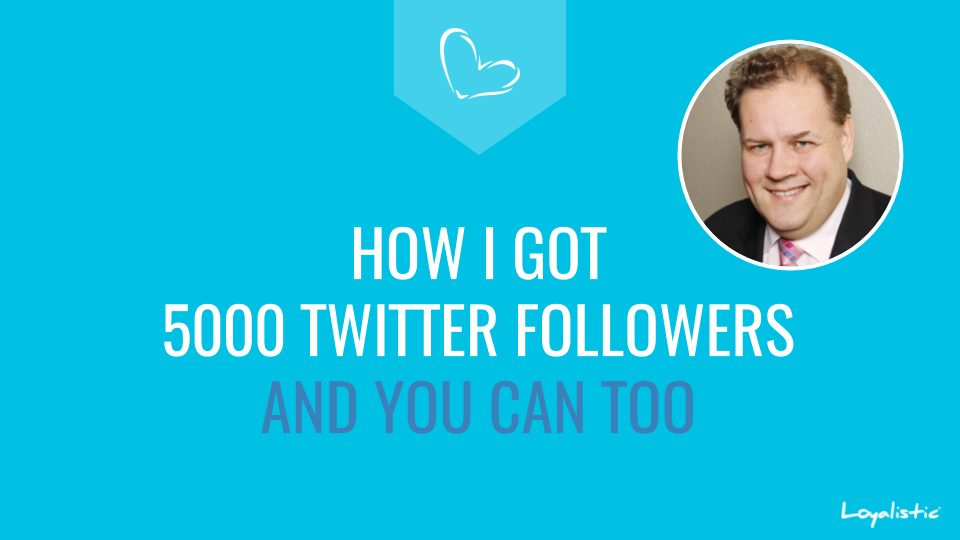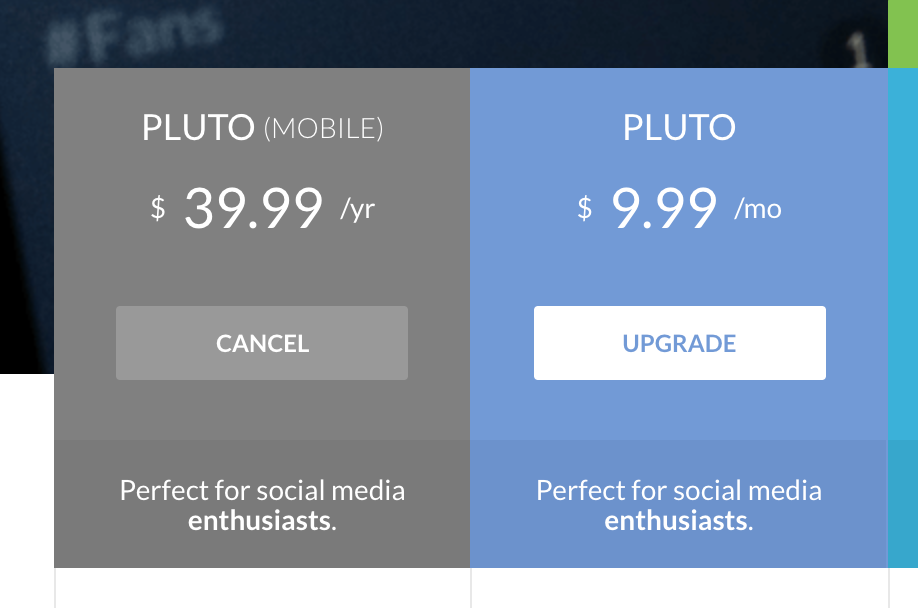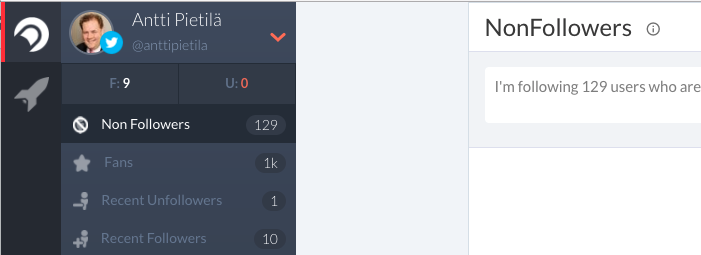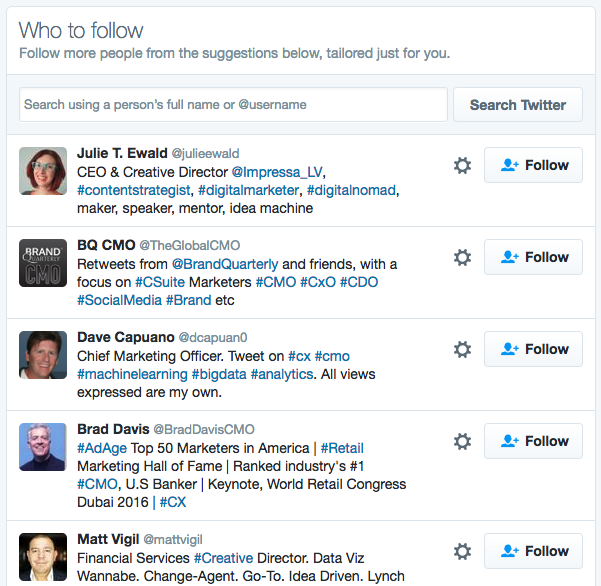
As a content marketer and social seller, Twitter is an important way for me to promote our content, build network and get leads, especially find new partners for my company, Loyalistic.

In this article, I’ll tell you the exact methods I have used to build my following to a healthy figure of 5000 highly relevant followers, and there is nothing you cannot use to achieve the same.
What is the value of a follower?
Now there are plenty of tips how to get more followers, and some sell them as a service for few bucks. You might have already been followed by several such Twitter accounts. So you might wonder why sweat when you can buy thousands with a tenner or aim for 10 000 or 50 000 as easily as for 5 000.
A follower from your target group or a very influential person might be worth big money. However a follower who cannot be a customer or does not influence those who can be, is worth nothing. Use effort to acquire followers who can provide value.
But having the right followers is not forth much in itself. It’s the value you can extract from them, and here the key is engagement. The more they click, like, retweet, comment or discuss, that is, engage with you, the more value you are going to get on average.
There is no point of paying for or spending countless hours acquiring random followers if the value is zero. Unless of course you see value in bragging about the number of followers. And you are not much more better off with 5 000 followers who do not really follow you.
While writing the last paragraph I was contacted by a follower interested about our software. The more right and engaged followers you have, the more active you are engaging with your audience, the more magic happens and the more value you get out of your followers.
In this article I’ll focus on tactics that have worked for me to get more and right followers and will get back to other tips and tricks later. I have been on Twitter since December 2008, however it tooks me many years to really get going and figure out how to get anything out of Twitter, and there have been years of passive coasting, so if you have just joined Twitter, fear not, these tactics will work for you.
So let’s get going with roughly the following steps:
- #1 Define the target audience
- #2 Follow back to retain right followers
- #3 Start following (right) people to be followed back
- #4 How to avoid hitting your head to Twitter’s 5000 following limit
- #5 Periodically Clean up your Following
- #6 Finding more people to follow
- #7 Curate interesting content to build and engage with your audience
- #8 Add value to anything you share/retweet
- #9 Live tweet and discuss to follow or to be followed
- #10 Create and share your own original content
#1 Define the target audience
First you need to know who you want to follow you, and what are their interests.
My company, Loyalistic, builds an easy to use cloud-based marketing and sales automation tool especially for small and medium sized knowledge-intensive businesses such as professional services and technology businesses. My target follower thus is a leader of such a business, person interested about business-to-business marketing or sales, consultant or service provider in the field and finally, as many of our clients are startups, startup advisors of all sorts.
I try to find people and businesses that match that loosely defined target group. I also try to share content that interests them. And we create our own content about customer acquisition and loyalty, content and inbound marketing, sales and a bit on strategy especially on B2B-context.
#2 Follow back to retain right followers
Increasing the number of followers is difficult if you are constantly losing followers. Many will follow you hoping you to follow back. If you don’t, some will leave. It is also difficult to build engagement if you don’t know (and follow) your audience. Thus I have chosen to follow back those who belong to my target group.
If you both follow each other, you can send direct messages. To avoid spam, I don’t follow back spammy accounts however a match they might look like, and I don’t follow back people that do not match my target audience, unless I have a reason or interest to follow them anyways.
Some will follow you waiting you to follow back and then unfollow. I will monitor these closely and will unfollow back. More of this ‘drive by following’ later.
#3 Start following (right) people to be followed back
The best tactic to grow your following is to follow people as many will follow you back.
First thing you should do is to start expanding your network by following right people. Go after people who are quite similar to you, a bit above, but not much. Follow entrepreneurs, experts, marketers and so forth. People from your industry and supporting industries.
People who are well above your league do not generally follow back. You can follow them, just don’t expect a follow back.
When you follow someone, Twitter will show them a notification. They will follow you back, if they are going to follow you back, next time they go to check Twitter’s notifications, that is for active users within hours or days. Active users may also use other tools that let them see new followers more easily. It seems to me, that if I follow bulk of people, they will follow back within couple of days, or during holidays next work day, but not much later.
Twitter has Who to follow feature which helps you on the way. It’s on the right or left depending on the page you are on. There is a View all-option to get long list of suggestions, although this does not seem to work on iOS app where it shows the same three suggestions as the widget itself. Who to follow is a good place to start. You can also import your contacts with Find friends-feature (more of that later).
I have found out, that Twitter often suggests accounts that have no recent activity. I will soon explain why that slows you down. Also Twitter suggests accounts that have very little interest overlap with you, that is, people who are not within your target audience. And finally you’ll find celebrities and other popular accounts e.g. Kim Kardashian West or POTUS (President Of The United States) at the end of the suggestions. You should not follow those, as they are not your audience, they won’t follow you back, nor engage with your tweets.
Find friends: Should you import your contacts?
You can let Twitter to access your Gmail or Outlook contacts with Find friends -feature (find it here). You can also allow this from Twitter’s mobile app. However you cannot upload your marketing list or such.
Depending how well your contacts represent target audience, this might be worthwhile or not. I think I have tried this, however, it didn’t provide much value for me and I have since removed all uploaded contacts.
For me the problem is that my Contacts do not contain many potential customers, influencers or customers, as they are in our CRM, however my Contacts do contain random people I have emailed with regarding let say our magazine subscriptions or whatever over the last 20 years. This would be a great feature if I could have uploaded a list from Loyalistic or our CRM. Especially if there would have been a sync between LinkedIn and Twitter, but no.
How to decide who to follow?
Take a look of each Twitter account you consider following. There are few things I do.
I quickly check Profile Photo, Name and Bio for cues such as hashtags and words that suggest the account is relevant to me as well as cues whether it might be spammy or fake account.
Then I check Followers and Following counts to see whether the account might be worth following and likely to follow back. Small counts suggest the account might not be active. So next I check tweets to see recent activity. Large counts suggest that the account is very active, however such an account might not retweet easily. Accounts that are following several hundred to thousands are most likely for me to retweet and engage.
At the same time I check Followers to Following ratio. People following more than are following them are probably hungry for followers and are most likely to follow you back. People with far more followers than following are far more unlikely to follow you back, unless you know them in person.
Then finally I check the Tweets count. Again very small number suggest inactive account whereas very high number, that is tens of thousands, suggest mostly automated tweets. Such accounts may retweet you, but are likely to have low engagement from their following, and will overload your Twitter feed. So I usually avoid them. The price you pay in terms of tweet noise is not worth it.
And if I have any doubts from the above checks, or the account seems very interesting, I’ll check latest tweets to see if the tweets are relevant, and maybe retweet something very interesting.
Finally, organizing accounts you follow to lists is a good idea. E.g. you might have a list for competitors, customers, partners, influencers and so forth. I have almost 30 lists, but seldom bother to add accounts to the lists. Too much work and the feature is not the best designed one. Again something Twitter should develop. If you have found an 3rd party app, that is really good for organizing accounts to lists, please let me know.
Should I follow people, organizations or both?
Both, but don’t expect much love back from larger organizations, thus they might not be forth following in the first place. Follow their executives or other key persons instead. They are more likely to retweet, and their social media teams often follow these closely, so you are more likely to get shared thru their main account that way.
#4 How to avoid hitting your head to Twitter’s 5000 following limit
Following people in order to be followed back as a strategy for expanding your following has some drawbacks.
You probably didn’t know that Twitter has a glass ceiling? But it has. You used to hit the glass ceiling with following 2000 accounts, but it has now raised to 5000. So if you try to follow more than 5000 accounts, you’ll get an error message.
You’ll see accounts that are following way over that, so indeed, there is a way around this ceiling. Twitter itself does not provide any exact information saying just that you need to have more followers before you can follow more. But how much? When I hit the previous ceiling of 2000 I did some research, and tried few things, and it seems that you need to follow roughly 1820 or now 4550 before the limit starts to rise. In other words, your Following limit is 5000 or 1.1 times your Followers whichever is higher. You'll find some background info here, here and here.
Drive by Following, that is Follow, then Unfollow
Some use aggressive tactics and automation to increase their following. They follow thousands, and then unfollow soon after, and do this automatically. This is against Twitter’s policy. It’s often quite easy to recognize these drive by followers as the accounts are quite spammy due to high automation. Don’t follow them back. And don’t use aggressive tactics or automation yourself.
#5 Periodically Clean up your Following
You need to clean up who you follow periodically for two reasons:
Firstly, not all you will follow, will follow you back, so your Following count is likely to be far bigger than your Followers count. That’s not a problem until you hit Twitter’s glass ceiling at which point your strategy stops working.
Secondly, your Twitter feed gets overloaded as you follow more. That’s on the other hand is how it often is with Twitter, trying to drink from a firehose. So you are likely to switch to searches and lists when using Twitter rather than the main feed.
So because of both reasons, you need to keep your following in order. You need to unfollow those who do not provide value.
And this is very difficult or practically impossible to do with Twitter itself, so I suggest using another tool for this.
Tool tip: Crowdfire
I have used Crowdfire, both free and paid versions, and can recommend. The free version has limit of 50 actions (follows, unfollows etc) per day which will get you far.
Crowdfire is available as a web app and mobile apps. Interestingly it’s far cheaper to buy from Apple App Store than as a web app. I just paid USD 39,95 for a year from App Store when if purchased from web, it costs USD 9,99 per month! So if you consider upgrading to paid, check this out.

Interestingly Crowdfire is far cheaper when purchased from App Store.
Clean up non followers
You need to use Crowdfire or similar for this.
Recently unfollowed. Check those who have recently unfollowed you. Unfollow back unless you have a reason to keep following.

Non Followers. Check those you don’t follow you. Some of those you might not expect to follow back. With paid version of Crowdfire, you can whitelist them so that they don’t show up on this list. On free version, you need to avoid accidentally unfollowing them.
If you have recently followed new accounts, allow enough time for them to follow you back. Crowdfire does not tell you when you have followed someone, so you have to know this yourself, which is obviously quite difficult to remember. So the best strategy is to have a quiet period when you don’t follow new people before your weekly/monthly clean up. My routine is to follow people on weekends and then clean up before next follow batch allowing them a week to follow back. A day or two might be enough though.
Inactive followers. There is no point of following people who are not active anymore. Crowdfire allows you to list accounts you follow that haven’t tweeted in 1, 3 or 6 months. If someone haven’t used Twitter for 6 months, it’s quite safe to unfollow. 1 month’s inactivity is quite common for busy business executives, and so is 3 months.
#6 Finding more people to follow
Once you have cleaned up who you follow, it’s time to add some more.

However Twitter’s Who to follow is often a let down.
The quality problem of Twitter’s Who to follow suggestions. Who to follow suggestions have a problem or two. For example today Twitter suggests I follow a guy with just 11 tweets. It’s not the number of tweets, but such an account is quite likely to become inactive compared to someone who have hundreds or thousands of tweets under her belt. The other problem is that it tend to suggest today accounts from two or three big organizations. If I have followed someone from that organization, what are the changes I want to follow the other 34 executives as well, probably trained to use Twitter as part of the same training because the organization want every executive be on social media. So for me the suggestions tend to be a let down.
Copy Followers
Another way to find who to follow is to go after other account’s followers. Take industry influencers or competitor for example. Find the account in Twitter, click open and click Followers. You’ll see all accounts that are following that person/organisation, and can follow their followers one by one expecting many to follow you back. Works great!
However if you are using Crowdfire, there is even better way: copy followers. Twitter lists all Followers regardless whether they are active or not, so you’ll follow many inactive accounts (and hit the glass ceiling) whereas Crowdfire lists actives.
Don’t go wild and follow them all though. That person you are copying followers from, might have other interests and followers for those interests as well, like local politics, a sports club, hobby.... So if you are blindly following her followers, you are likely to get many followers that are unrelevant to you. And even worse, a lots of drive by followers, spammers, shady and fake accounts. And soon you start getting direct message and mention spam from those.
Finding people to follow with hashtags
You are after people who are interested about the same things you are (trying to sell/market), right? Search by hashtags in Twitter to find who are sharing or commenting on that subject. If you click People, Twitter will show people and other accounts who that hashtag in their profile. You’ll find Search filters on the left. Filtering to people near you is often valuable, unless you market worldwide. Then follow to be followed back.
Crowdfire offers similar feature but lists active accounts whereas Twitter’s list may contain less active accounts.
#7 Curate interesting content to build and engage with your audience
Nobody will follow you long if you don’t have anything interesting to share. And obviously you need to get something out of the followers as well, that is to sell or market something. I won’t dig deep into how and what to share, just mention what is important to remember in the context of expanding your following.
Finding and sharing content as an activity is called Content Curation.
4-1-1 rule
Originally coined by Andrew Davis, the 4-1-1 rule described that a healthy social media account should share 4 parts of curated content, that is something you haven’t produced, 1 part of content you have created and thus allowing that 1 last part to be promotional content.
It’s obviously not a strict rule, rather a health check that works for content marketing, social media influencing and many tactics more. Nobody is interested in your ideas unless you are interesting to follow for other reasons, that is 4-5 parts of 6 needs to be interesting and valuable opening you that one slot to promote your agenda, whatever it is. However, it’s good to remember, that your agenda is shown also on the content you choose to share.
Finding and sharing content as an activity is called Content Curation.
You can do it by finding and retweeting content within Twitter. Or you can find the content elsewhere and share it in Twitter.
I am not going to get deep into Content Curation advice now, let’s save that for another time. Few important things to remember though.
#8 Add value to anything you share/retweet
Think about the value you create by sharing content. You help your followers to be on top on your topic(s).
If your main strategy is to share, that is retweet, within Twitter, you have to ask if you are adding value or not. It is very easy to be a follower, an account that shares stuff, that has already been shared by the real influencers. If that’s the case, why would someone follow you instead of the real influencers that add value.
If your main strategy is to curate content, let say blog articles and share them to Twitter, you have to ask whether you are working hard to find content that has already been shared by someone within Twitter.
Thus I would not select either strategy, but mix both. And try to add value with tips I soon share with you. And it’s good to remember that it might be value adding to pick 1 article to your mainstream followers from the 10 posts experts share. Mainstream won’t follow experts as the content tends to be too deep, too thorough.
Luckily there are few easy ways to add value.
Add value by hashtagging
You can easily add value, especially when sharing blog posts etc web content to Twitter by adding relevant hashtags. Share-buttons usually take just the heading as it is. So most shares of the post doesn’t contain any hashtags and are thus not easily findable by those who follow that hashtag. Often it just means adding couple of #-characters.
Add value by mentioning
Most share-buttons do not add author’s Twitter handle to the prefilled share text. You can easily add value, get noticed by the author and create goodwill by mentioning the author. Check if the article already has author’s Twitter handle somewhere, or go to Twitter to find if the author has one. Now add that handle to the share.
Add value by commenting
Again most share buttons just share the heading and link. But why are you sharing it? Why should someone read it? If it’s a must read, say so. If the real point is something else than the heading, use that instead. Remember hashtags and mentioning the author and possibly the site for example:
A must: Use Google #Analytics Goals to Measure #Lead #Generation From #B2B #Content #Marketing by @deveshkhanal https://t.co/Emovm58IAB
— Antti Pietilä (@anttipietila) December 5, 2016
When you mention author and/or site, they will be notified by Twitter and are often likely to retweet especially if you said something nice or raised a point their own share didn’t mentioned. Many will even follow you.
Ping people
Sometimes you find something that should be shared by or interests someone. I just shared an article many must have shared before me. However I knew an industry influencer and organization who has not and that article was perfect match to their agenda. So I pinged them, and soon my tweet was retweeted and shared by other influencers. Follow them to be followed back.
#9 Live tweet and discuss to follow or to be followed
One great way to find new relevant people to follow is to join discussions, and follow the other people joining (they are mentioned) in the comments.
Event live tweeting is a great way to take notes for yourself as well as create value and find new people to follow (to be followed back). You sit there for an hour or two listening. Take that smartphone out of your pocket, take photos of the most interesting slides and share using the event’s hashtag as well as with suitable topical hashtags. Remember to mention the speaker and organizer. Say nice things!
Speakers often loves when you take a photo of them speaking, as they cannot. So follow, shoot, share with mention, and they will soon retweet and follow.
#10 Create and share your own original content
Finally we are getting to why I am doing all the above. It is to build audience for my content like How to publish and promote an eBook for lead generation. http://blog.loyalistic.com/en/publish-and-promote-your-ebook-for-leads-the-right-way
At the same time every piece of content I share helps me get few more followers. If you are unknown in the field which does not have good hashtags with large audience, or your space is crowded by consultants like mine, it’s hard to get noticed with small following.
When I am training and advising businesses on inbound marketing (Inbound Marketing and Sales Explained) and we get this article’s topic of how to get Twitter followers, I recommend start building audience like mentioned #1-#9 and #10 comes into play when there is new original content to share. So my advice is to start building Twitter following immediately before even starting content creation, and when you have that first blog ready, you already have an audience whom to promote it. More tips on my post: how to promote your blog posts.
That’s all folks!
If you thought you will just get Followers, that’s not going to happen. If you have an existing fan base or following, they might just be waiting to find and follow you on Twitter. However, if you are just an average (business) guy, the following won’t happen. You need to build it.
You have just learned the tactics I have used to build mine to 5000. Now it is your turn. Start growing your following. Try these tips, find others or invent your own!
 |
Written by Antti Pietilä Antti is the founder and CEO at Loyalistic (Simple Content Marketing Software for B2B Companies) who loves to help SaaS-companies to grow at Software Entrepreneurs (@ohjelmisto_ry) and cycle. Say hello to him anytime @anttipietila. |
